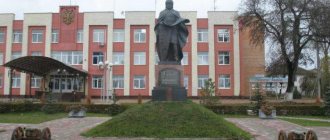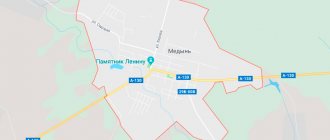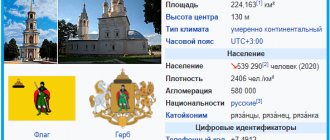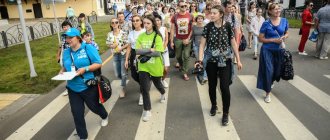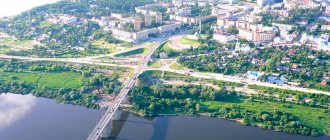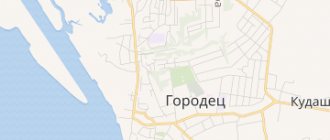The Fatherland of the Two Queens - the city of Meshchovsk
Date: 04/12/2011 Author: TIMOFEEV Yuri Region: Kaluga region
The Kaluga region, as statistics show, ranks first among the constituent entities of the Russian Federation in terms of economic development rates. The tourism industry is also developing very actively in the region. Until recently, the face of Kaluga tourism was as recognizable as it was familiar. On the one hand, there are numerous monasteries famous for their shrines - Optina Pustyn, Shamordino, Tikhonova Pustyn, Pafnutev Borovsky Monastery. On the other hand, there is a space theme associated with the stay of Konstantin Tsiolkovsky on Kaluga soil, to whom museums in Kaluga and Borovsk are dedicated. Plus, the city of writers, artists and dissidents, Tarusa, which became famous in the last century.
However, there are still many wonders and attractions hidden in the Kaluga outback, almost unknown even to tourists in the capital. At the 228th kilometer of the M3 federal highway there is a turn to the ancient town of Meshchovsk (about 5 thousand inhabitants) - 12 km away. I recently organized a study tour there.
Meshchovsk was first mentioned as a “town of the Seversk land” in 1238. Having suffered a lot from the hard times of war, including the last one, it was subsequently famous for both the highly revered St. George Monastery (photo) and the strong, homely merchants who decorated the city with five churches.
Four of them survived, in varying states of preservation. The main one is the New Annunciation Cathedral (photo) of the first half of the 19th century with a free-standing 70-meter bell tower and chimes would be appropriate in large provincial cities. Today's Meshchovsk is also interesting for its typical, but very typical for small provincial towns, low-rise residential buildings of the second half of the last century.
Meshchovsk is also famous for people who left a noticeable mark on Russian history and culture: the prominent publicist of the late 19th century Nikolai Mikhailovsky, the wonderful children's poet Valentin Berestov. However, Meshchovsk became most famous as the birthplace of two Russian queens - Evdokia Streshneva and Evdokia (Praskovya) Lopukhina. It is not for nothing that the ancient settlement of Meshchovsk is called the Tsaritsyn Kurgan. Another Russian queen, Natalya Naryshkina, was born in Tarussky district.
It is the queens who can provide Meshchovsk, as well as the Kaluga land as a whole, with a fairly prominent place in tourist routes dedicated to the upcoming 400th anniversary of the Romanov dynasty in 2013. Why, by the way, shouldn’t the small towns of Russia associated with the “Romanov” theme (the same Meshchovsk and Tarusa, Uglich, Suzdal, Nyrob, Kashin, Kirzhach and others) join forces in the tourism field on the eve of the anniversary?
It is planned to install an already cast monument to Evdokia Lukyanovna Streshneva (photo) in Meshchovsk. The second wife of Mikhail Fedorovich Romanov came from a very poor noble family and arrived in Moscow, for the viewing of the royal brides, as a servant of one of the contenders. But the first king in the dynasty and reputed to be weak-willed, contrary to the will of his mother, nun Martha, chose the “thin-born” Evdokia.
The daughter of the Tsar's steward, the first wife of Peter I and the last Russian Tsarina Praskovya (the more “befitting” name for a reigning person, Evdokia, was given to her at the coronation), Illarionovna Lopukhina (photo) was born in the family estate, an ancient village called Serebryano, which is four miles from the center Meshchovska. It received its name in honor of the silver mines that were once mined in these places.
Subsequently, Varvara Borisovna Lopukhina, the daughter of Field Marshal Sheremetyev, built a manor house on the estate, on the site of which a collective farm office, which disappeared at the turn of the century, appeared in Soviet times.
And it is very symbolic that it was here, in Serebryano, near the ruins of a landowner’s house, near the remains of an old park, near the estate Assumption Church built in 1705 that Meshchov tourism was born several years ago.
The rebirth of Meshchov estates
Several years ago, on the foundation of an old Lopukhin house, businesswoman Alevtina Gavrilyuk built a guest house (photo) for 30 people (with additional beds for up to 40). It, of course, does not repeat the architectural forms of the Lopukhins’ estate house. Moreover, there is virtually no information about what he looked like. But stylistically, the small hotel is designed exactly in the spirit of an ancient noble nest.
The guest is greeted by relics of bygone times: cabinets made by serf craftsmen, antique carpets. It is planned to open the only museum of kerosene lamps in Russia at the estate. The heart of the house is a spacious hall (photo) with a capacity of up to 60 people, where all kinds of balls, assemblies and corporate events can be held. Nearby is a winter garden.
The cost of living in a regular double room is 1000 rubles, in a two-story luxury room – 1200 rubles. The cost of three meals a day is 600 rubles.
Opposite the house is the once again functioning Lopukhin Assumption Church, built in 1705, where a women’s monastery is being built. An ancient park is being revived around the house itself. The old pond, which has long been called the “royal bath” (photo), has been restored and cleaned. It was repopulated with crucian carp and crucians, and a bathhouse with a billiard room was built on the shore.
Every self-respecting Russian landowner on his own estate always sought to amaze the visiting guests with something. One started a serf theater, the other - an outlandish greenhouse. And many spared no expense on menageries. Many different representatives of the fauna still live today in the Serebryano estate. Two bear brothers - Chuk and Gek (photo). A small herd of Bactrian camels. Noble deer. Porcupine. Raccoons. Peacocks. Dwarf pigs. The kids' favorite is the donkey. And, naturally, a varied, numerous and vocal kennel.
8 km from the Lopukhins’ estate there was another estate – Zenovka, founded in the second half of the 18th century and subsequently merged with the neighboring estate and the village of Shalovo. At the turn of the 19th and 20th centuries, this “noble nest” was redesigned and rebuilt. The abandoned two-story main house of the early 20th century, the Trinity Church, and a park with 200-year-old linden alleys have been preserved. To this day, these places are famous for their holy spring (photo), the water of which, saturated with silver ions, is considered one of the most healing in Russia.
The current owners of the Serebryano estate in Shalovo on the shore of the lake, around a forest and field, built a village with wooden houses for 6-7 people with all amenities (cost of living - 3000 rubles) On the shore of a lake exceptionally rich in fish (silver carp, white and red carp, carp, pike), beach. The estate has hunting grounds (21 thousand hectares), where wild boars, roe deer, moose, foxes, hares, woodcock, and beavers live.
A month ago, in the center of Meshchovsk, in an old mansion, a “traditional” hotel with 24 beds (accommodation costs from 500 rubles per person) with a cafe opened.
In a word, the infrastructure is there. It's up to the tourist groups, who, it seems, won't keep you waiting, although, and the Kaluga administration is well aware of this, the road from the federal highway to Meshchovsk today leaves much to be desired.
“In May, we are launching the first two-day route, including visits to Borovsk, Maloyaroslavets, Kaluga and Meshchovsk - with an overnight stay at the Serebryano estate,” says Irina Astakhova, director of the Russian office. – But on Kaluga land and besides Meshchovsk there are many places worthy of the closest attention of tourists. For example, the Ethnomir park located near Borovsk is one of the largest modern tourism projects. Or the ever-growing Bird Park. Or the little-known Puppet Museum, created by Rimma Tarasova in the village of Kozlovo not far from Kaluga. Or a unique natural monument - Devil's Settlement near Kozelsk. Their tourist development is a matter of the near future.”
Let us add that there are miracles in the Kaluga region that are practically unknown even to experienced local historians. Like, for example, the completely abandoned Lvov estate - Bogorodskoye, with the preserved main house and the marvelous Kazan Church of 1719 (photo), located in the Ferzikovsky district not far from the Kaluga - Tarusa road. But there is no actual road into it at all. Maybe Meshchov's experience will be useful?
More about Kaluga region
Expert opinion
The quiet and picturesque town of Meshchovsk is located in the heart of the Kaluga region , on the Tureya River. This is one of the oldest among many small cities, whose origins go deep into Russian history. The first evidence of him was found in the chronicle - “The Degree Book” of 1238.
Kaluga land is the birthplace of Russian queens. A native of Meshchovsk became the ancestor of the Romanovs. The Kaluga region nurtured three generations of Russian tsars until the tradition of marrying foreign princesses was born, who, by the way, were already called empresses. The exhibition of the Museum of the Three Queens in Meshchovsk is dedicated to the history of Russian queens and the Romanov dynasty.
In the ancient city of Meshchovsk, the Museum of the Three Queens was opened on September 11, 2015 as part of state support (grant) for large, medium and small cities - centers of culture and tourism within the framework of the Heritage and Art of the state program of the Russian Federation "Development of Culture and tourism" aimed at preserving the historical appearance of small towns. It is located in the city center on the banks of the Tureya River, in the building of the former house of the Tisov merchants, who before the 1917 revolution were engaged in tanning hides. The house is a two-story building from the second half of the 19th century. After the revolution, several Meshchov families lived in the house. In the 50s, the building was transferred to the regional department of public education and it housed the House of Pioneers. In the 80s of the last century, the Meshchovsky DOSAAF was located in the building. The building has not been used for more than 20 years.
The building was restored as a museum in 2015. 23 million 800 thousand rubles were allocated from the federal budget for the creation of the Meshchovo Museum of Local Lore, dedicated to the three first queens of the House of Romanov.
The museum exhibition was created with the participation of the Kaluga Regional Museum of Local Lore. In total, the museum displays about 500 exhibits. On December 30, 2016, the Museum of the Three Queens was officially transferred to the jurisdiction of the Kaluga United Museum-Reserve (formerly the Kaluga Regional Museum of Local Lore).
The exhibition on the first floor is the history of Meshchovo land from the 12th century.
On the ground floor of the museum there is an exhibition dedicated to the ancient Serensky and Meshchovsky settlements and the history of the Meshchovo land. The presented exhibits were found during archaeological excavations at the Serensky settlement, which began in the 19th century.
One of the most notable exhibits is a model of the ancient city of Serensk , the cultural center of the Vyatichi, as well as archaeological finds indicating the life of the ancient city. The model shows a fortified settlement located on the high right bank of the river. Serena, at the confluence of an unnamed stream. The settlement consists of a detinets and a surrounding town. Detinets is separated from the surrounding town by a high rampart and a deep ditch. The outlying city is also protected from the ground side by a powerful rampart and moat.
Since the beginning of the 1st millennium AD. e. On the site of the settlement there was a fortified settlement of the Moshin culture. In the 11th century, the Vyatichi settled here, increasing the area of the fortified settlement. Since the 12th century, the outskirts of the city were part of the Chernigov principality. The city was first mentioned in the “Chronicle of Pereyaslavl of Suzdal” in 1208. The Resurrection Chronicle reports that in 1232 the city was burned by Yaroslav Vsevolodovich . In 1238 the city was ravaged by Batu, in 1480 by Akhmat . In 1492 it was taken by the Moscow army. The cultural layer on the site can be traced back to the 17th century.
Serensk also became famous as the legendary place of death in 1110 of the hieromartyr Kuksha Pechersk . In honor of this event, it is planned to build a monastery on the site.
The first excavations at the Serensk settlement were carried out in 1898 by N.I. Bulychov . In 1965-1985, the Verkhneokskaya expedition of the Institute of Archeology of the USSR Academy of Sciences, led by T. N. Nikolskaya , worked at the site, in 1986-1989, 1997-1998. - archaeological expedition of the Kaluga Regional Museum of Local Lore under the leadership of T. M. Khokhlova.
The area of the fort is about 4 hectares; it consists of a fortified town and a surrounding town, fortified with powerful ramparts and ditches. Adjacent to the city were settlements (the total area of settlements is more than 25 hectares), and settlements located on the opposite bank of the Serena (in the territory of the modern village of Nikolskoye).
Iron smelting furnaces, a forge, casting molds with Cyrillic inscriptions for the production of hollow jewelry (colts, beads, temple rings), workshops for the production of glass bracelets and rings were found - violet glass jewelry was produced.
A wealth of material has been collected: household items made of iron (knives, locks, keys, chairs, scissors), jewelry made of bronze, copper and silver (temple rings, rings, bracelets, hryvnias), weapons (spear and arrowheads, maces, fragments of lamellar armor, battle axes, a forged mask - one of the rare finds of this type on the territory of Russia, which is a cast of the face of a Caucasian person), etc.
Much of what is listed can be seen in museums. The collection characterizes the high development of crafts in this small ancient Russian town, lost in the Vyatichi lands.
The trade connections of the city are evidenced by the following finds: slate spindle whorls from Volyn, Novgorod amber items, a Kiev mace, encolpion crosses and foundry molds for making jewelry, Novgorod and Kyiv type hryvnias.
Found crosses, encolpions, and icons depicting St. George indicate the spread of Christianity among the local population.
The second floor hall is dedicated to M. F. Romanov and three Russian queens
In 1613, Mikhail Fedorovich Romanov . He took as his wife Evdokia Lukyanovna Streshneva (c. 1608-1645), the daughter of the Meshchovo nobleman of the Kaluga province. The pantheon of the Streshnev family of nobles is located in the St. George Meshchovsky Monastery. Evdokia Streshneva in 1626 became the second wife and mother of all children of Mikhail Fedorovich (1596-1645). This happy marriage produced nine children.
The second queen, Natalya Kirillovna Naryshkina (1651-1694), was born in the village of Trostye, Tarussky district, Kaluga province. She became the wife of Tsar Alexei Mikhailovich (1629-1676), who reigned since 1645. Natalya Naryshkina - mother of Peter the Great (1672-1725), Tsar from 1682, first Russian Emperor from 1721.
Another queen born on Meshchov’s land was Lopukhina Evdokia Fedorovna (1670-1731), Elena as a monk. She was born on a family estate, in the village of Serebryanoye, Meshchovsky district, Kaluga province. She was the last Russian queen, the last Russian monarch on the Russian throne, the first wife of Peter the Great (1689-1698)
In addition, the museum has two halls for housing changing exhibitions. On the third floor there is a conference room and an exhibition dedicated to the life of the inhabitants of Meshchovsk from the mid-19th to the beginning of the 20th century.
Towels were provided by city residents for the duration of the exhibition.
It should be noted that the residents of Meshchovsk take an active part in the formation of the exposition, who donate their rarities for temporary and permanent use.
The women's costume of the Vyatichi people was donated to the museum by Alevtina Alekseevna Gavrilyuk, a respected businesswoman and philanthropist in Meshchovsk.
Temporary thematic exhibitions are located in the rooms in front of the main halls. During my visit, a photo exhibition “The Red Book of the Kaluga Region” was presented. The uniqueness of the museum is also in the amazing smell of wood that lingers there. This cannot be conveyed in words and photographs. Cleanliness, comfort, sincerity - all this was created and maintained by the museum team.
From the windows of the third floor there is a beautiful view of the city of Meshchovsk. The area around the museum is also a continuation of the exhibition. There is a plate installed here, which reflects that this place is the center, the zero kilometer of the Kaluga region.
The museum is located at the address: Kaluga region, Meshchovsk, st. Kachurina, 2.
Contact numbers for booking excursions: +7(48446) 9-20-66, Natalya Aleksandrovna Melyuchenkova, Alla Sergeevna Kostikova.
Markanova Tatyana, Euro-Asian news agency “TANYANA”
Meshchovsky district is located in the center of the Kaluga region. It borders with six districts of the Kaluga region: in the southern part with Sukhinichsky, in the western part with Baryatinsky and Mosalsky districts, in the northern part with Yukhnovsky district and in the eastern part with Babyninsky and Kozelsky. The district includes 5 municipalities: Urban settlement - the city of Meshchovsk and 4 rural settlements. There are 175 settlements in total. The administrative center of the district is the city of Meshchovsk .
Territory - 1237.7 sq. km. The population in the area is 12.2 thousand people.
Meshchovsk first mentioned in chronicles in 1238. Throughout the history of its existence, the city has had different names; it is known as Mezetsk, Mezchesk, Mezechevsk, Meshchersk.
In the 14th century, the city came under the rule of the Grand Duchy of Lithuania, and in 1503 it was transferred to Moscow. In 1584, the Crimeans and Nogais greatly devastated the outskirts of Meshchovsk, but they could not take the city itself, fortified with a wooden wall with six towers.
During the Time of Troubles , Meshchovsk successfully withstood the siege of the troops of False Dmitry II.
In 1708 the city was assigned to the Smolensk province, and in 1719 - to the Kaluga province. In 1776, Meshchovsk was included in the Kaluga governorship as a district town.
The Meshchovo district included most of the territories of neighboring areas. The main occupations of the residents were agriculture and waste industries.
Meshchovsky district differed from its neighbors in its increased production of industrial crops, mainly hemp. Factory activity in the district was not developed.
The Meshchovsky district dates back to the formation of the Meshchovsky district as part of the Kaluga province according to the Decree of Catherine II of August 24, 1776.
According to the administrative division of 1929, the Kaluga province was abolished, and in the same period the Meshchovsky district was also abolished. The newly formed Meshchovsky district became part of the Smolensk region and remained there until 1944.
By Decree of the Presidium of the Supreme Soviet of the USSR dated July 5, 1944 No. 801/1, the Kaluga region was formed, and the Meshchovo district became part of it.
The municipal entity " Meshchovsky District " is included in the List of Municipal Entities of the Kaluga Region on the basis of Decree of the Government of the Kaluga Region dated August 21, 1996 No. 30 "On the inclusion of the Meshchovsky District in the List of Municipal Entities of the Kaluga Region."
In accordance with the above decree of the Government of the Kaluga Region, the municipal formation “ Meshchovsky District ” was created within the existing administrative boundaries of the Meshchovsky District.
Today, the main element of the economic base of the region is agriculture, the level of development of which largely determines the standard of living of both the rural and urban population.
The climate of the Meshchovo district , like the entire Kaluga region, is moderate continental with clearly defined seasons. It is characterized by warm summers, moderately cold winters with stable snow cover, and well-defined but shorter transition periods - spring and autumn.
Two rivers originate in the region - Serena , which is a tributary of the Ugra , and Techa . Large rivers - Serena, Tureya .
The Moscow-Kyiv highway and the railway line in the same direction run through the 25 km long area.
Among the attractions of the area are:
In 1983, a monument was erected on the main square of the city - a model of a TU-2 bomber aircraft . In Victory Square there is a mass grave of Soviet soldiers who liberated Meshchovsk on January 3–6, 1942. In 1988, a memorial to Meshchovite soldiers who fell in battle was created.
St. George Meshchovsky Monastery (Half a mile from Meshchovsk ; late 15th century - 1626)
Novo-Annunciation Cathedral (City of Meshchovsk . 1832; Bell Tower 1854-57)
Peter and Paul Church (City of Meshchovsk .)
Temple in honor of the Annunciation of the Blessed Virgin Mary (City of Meshchovsk . Built in 1696; The three-tiered bell tower stands separately, to the southeast of the temple. According to some sources, it was built together with the temple in 1678, according to others - later, during the Naryshkins (beginning of the 18th century).)
Temple in honor of the Transfiguration of the Lord (City of Meshchovsk , built unknown. In 1919 it was closed.)
Kozlovsky estate (Village Baryatino. second half of the 18th century)
Temple in honor of the Savior Not Made by Hands (Koptsevo village.)
Temple in honor of the Vladimir Icon of the Mother of God (Village of Kudrino. Built in 1788 with the money of Pyotr Ivanovich Barsky.)
Michael the Archangel Church (Village of Laptevo. late 17th century)
Temple in honor of St. Blessed Prince. Alexander Nevsky (Moshchonki village. Built in 1755 on the site of an old wooden church in the name of St. Alexander Nevsky, in the estate of Prince A.A. Urusov, it is an architectural and historical monument of republican significance.)
Temple in honor of the Dormition of the Blessed Virgin Mary (Serebreno village. Built in 1705 at the expense of F. A. Lopukhin.)
Official website of the district administration: www.meshovsk.ru
Private advertisements in Meshchovsk, Kaluga region and Russia
To add an advert
Kaluga
Repair VESPER EI E2 E3 7011 P7012 9011 9100 8300 MINI P7002 8001 often...
Kaluga
Let's remove the voice from the song or, conversely, remove the music from it
Kaluga
High-quality and inexpensive furniture in the Conforta online store
Kaluga
Satellite and digital television services.
123ru.net
- minute-by-minute news with a daily archive. Only here we have all the main news of the day without political censorship. “123 News” - absolutely all points of view, sober analysis, civilized debates and discussions without mutual accusations and insults. If you don’t like it, don’t want to hear it, don’t read it, read it, be mutually polite and correct in your statements. Remember that not everyone's point of view coincides with yours. Respect the opinions of others, even if you defend your views and your position. 123ru.net is a news observer. We do not impose our vision on you, we give you a snapshot of the events of the day without censorship and without cuts. News as it is—online with minute-by-minute archives for all cities and regions of Russia, Ukraine, Belarus and Abkhazia. 123ru.net - live news live! A quick search from 123ru.net is not only the opportunity to be the first to know, but also the advantage of reporting breaking news instantly in any language in the world and being heard right away. You can add your news at any moment - here.
History[edit]
Historical affiliation
Principality of Mezec 1238 – ca. 1400 Grand Duchy of Lithuania ca. 1400–1503 Grand Duchy of Moscow 1503–1547 Kingdom of Russia 1547–1721 Russian Empire 1721–1917 Russian Republic 1917 Soviet Russia 1917–1922 Soviet Union 1922–1991
Russian Federation from 1991 to present
It was first mentioned in Russian chronicles in connection with the Mongol invasion of Russia in 1238. [ edit
] During the Middle Ages it was the fiefdom of Princes Mezetsky.
Catherine the Great granted him city rights in 1776 [ edit
]
During the Great Patriotic War, Meshchovsk was occupied by the German army from October 7, 1941 to January 7, 1942.
In Meshchovsk, on the ancient Kaluga land
I was unexpectedly offered to participate in the delivery of a miraculous copy of one miraculous icon of the Mother of God to the St. George Meshchovsky Monastery.
Before the revolution, there were about 180 churches in the area. They were mainly dedicated to the Mother of God. In Meshchovsk itself there are 2 operating churches and both of them are dedicated to the Annunciation. The city has about 5 thousand inhabitants. A native of Meshchovsk is Evdokia Streshneva, the mother of Mikhail Romanov. A monument was erected to him in front of the entrance to the St. George's Monastery.
The first wife of Peter I, Evdokia Lopukhina, was born here. Meshchovsk confronted Peter: they told him: do not appear in our places, because you offended our maiden. Not far from the monastery in the village of Serebryano, her estate has been preserved. Now it belongs to a wealthy woman. The owner of the estate, Lopukhina, maintains a whole menagerie, which includes wolves, bears, ponies and a camel.
Opposite is a women's monastery with the Assumption Church. In this temple the revered icon of the Mother of God “I am with you and no one is against you.” The temple is more than 300 years old. The monastery is headed by nun Feofania. The territory of the monastery is 10 hectares. There are also fields with an area of 20 hectares. The psalter is constantly read in the refectory. Here is a list of the prayer icon of Metropolitan Philip “Bread”. The temple and the monastery buildings are heated with wood. Lenin demanded that kobzas, lyres and harps be removed from the villages, since playing them, accompanied by spiritual chants, preserved the pious spirit of the people. And Meshchovsk ordered to crush them to smithereens.
Today there are 30 monasteries in the Kaluga Metropolis. There are 30 churches in the area and they are all ancient. There are 5 monastic communities. There are about 40 monks in the Meshchovo St. George Monastery, and there are monasteries where there are about 150 of them. The monastery has a large farm, including an experimental potato field, fields producing twenty tons of cucumbers, a ton of onions, etc. The number of cows numbers one hundred units. There are cows that produce up to 40 liters of milk per day. The monastery farm has 50 sheep and 100 chickens. There are three gardens. There are no factories within a radius of 100 km. Cleanest ecology. The most fertile lands. Several dozen elderly nuns and novices live behind the monastery wall. They sing on the wing, clean the temples, and help a lot with the housework. About 100 people eat in the refectory every day. The monastery takes care of the Center for Creative Development in honor of the icon of the Mother of God “Education”. There are about 600 children in the center. A House of Mercy with a medical center is being built. There was a religious school within the walls of the monastery. At one time, Father Valentin Amfitheatrov taught there. In the main church of the monastery there are many pieces of relics of saints. There are, in particular, the rib of the martyr Boniface and the head of the Baby of Bethlehem.
The rector of the monastery is Abbot Georgy (Evdachev) - I met him back in the 90s in the city of Obninsk. I came there for the funeral of Archpriest. Vadim Krasnotsvetov (he was buried in the cemetery in Borovsk). Father Gennady (that was his name before he became a monk) told how one day Fr. Georgy Kochetkov. About 600 people came to meet him. During this meeting, Fr. Vadim stood up and said Fr. George: “You are not Orthodox!” And he left the hall. Company. Almost everyone present followed Vadim. In Obninsk, pro-Catholic sentiments were very strong among the clergy and intelligentsia. The recently ordained O. Gennady was thrown into a breakthrough. He was given the task of turning the tide in the city that the Vatican had chosen as its springboard. Fr. Gennady was instructed to propose to the philo-Catholic-minded dean Fr. Rostislav assistance in holding the Christmas tree. He sharply refused (he is now the abbot of a Catholic monastery).
O. Georgy is the confessor of the local governor. Not long ago, Metropolitan Clement and his father performed the funeral service for his father. Personally, I never came into contact with Metropolitan Clement, although I remember his assistant. inspector of the Moscow Theological Seminary. It always seemed a bit dry to me. According to Fr. George, the Metropolitan’s services are conducted calmly, clearly, reverently, prayerfully, without extraneous conversations. When he is dissatisfied with something, the harshest thing he can say is: “Dear.” He is not picky about food, silently eats any food offered, for example, jacket potatoes. What is very important is that he does not tolerate any extortion or offerings. Once, at the Diocesan Council, one young priest was clearly rude to the metropolitan, to which he calmly reacted. Having come to his senses, this priest apologized. The Bishop does not ordain applicants for the priesthood with obvious canonical obstacles (they then go to where everyone is ordained). On the Feast of the Nativity of Christ, he accepts congratulations until midnight and does not sit down.
O. Georgy is a native of Kaluga land. When he was appointed abbot of the monastery, there was an almost open field and the skeletons of two ruined churches. Fr. was born. George in the large village of Zhilino (it had about 400 households). Native village of Fr. Georgia was the only one in the region who did not go to the collective farm, although at the beginning of the century residents were actively settling in farmsteads. One woman reasoned this way: “I will work only for myself, but if my neighbor’s children go hungry, I will help. I get up very early and go to bed very late. And there are those who sleep almost until lunchtime. How can there be equality?!” The villagers were subject to increased taxes. Seven men were arrested. One woman who had a two-week-old baby asked for a warm blanket for him. To which the guard said to her: “Why? The little dog will die - he won’t survive in Siberia.” Father Georgy said: “Solzhenitsyn in his “Gulag Archipelago” did not describe all the ordeals - he either did not know some things or kept silent about them. For example, that there were cases when men were castrated without anesthesia. When one of them returned to their native village, they settled apart.”
All manifestations of life were accompanied by appropriate rituals and prayers. So, before going into the forest, a special prayer was read. The berries were collected in mugs; they were not supposed to be eaten. When the mugs were filled for the first time, they were poured onto a tree stump and they prayed for the repose of their relatives. The stump in this case was, as it were, canon. The accompanying woman told the children: “If you get lost, then pray to your departed relatives - they will help.” When the children wanted to eat, the necessary food was wrapped at the end of the accompanying scarf. And with the help of the end of the scarf in front, you could drink water from the puddle.
I remember this incident from the story of Fr. George. The atheists came to close the temple. The priest, having gathered his closest assistants, told them to sit on the table and, taking spoons in their hands, hit them. The priest himself, having opened the Royal Doors, began to play the balalaika. People are confused, but the priest insists that they play and sing along. The commission enters the temple, and there everyone sings “The moon is shining, the red one is shining.” The head of the commission, seeing this picture, exclaimed: “Yes, here is a ready-made amateur group. These people keep up with the times." When the commission left the temple, which was intended to be closed, the priest said: “Now let’s cry and repent.”
The most important issues affecting all residents were resolved at the village meeting. They set up a table in the square, at which the elders sat and listened, for example, to candidates for shepherds, who had what conditions, how much to pay, and when the weekend was. Two were chosen from several candidates by open voting. If the old people made a remark that one of the children did not bow to them when they met, then the parents of these children asked the old people for forgiveness. If the old men pulled the ears of the boys for this offense, the mothers also thanked them for this. Weddings were managed by godfathers. If after the first wedding night it was revealed that the newlyweds had maintained their purity before marriage, then the matchmaker would raise a red scarf and begin to dance. If this was not the case, then there was not much fun at the wedding. “The mother-godmother used to be the hostess at the wedding.” “The first two days are spent with the groom, the next two with the bride. On the fifth day, the bride is transferred to the groom. This is a separate ceremony. At the wedding, the bride and groom do not drink and almost do not eat, and at their side or behind their back is a holy image like a Guardian Angel. It’s amazing: the wine flowed like a river, but there were no drunkards, and they worked - you couldn’t keep up. And no fights, no shameful ditties, like now.”
There could be no more than one or two “sluts” (women of reprehensible behavior) in the entire village. They were held in contempt. They tried to cut their braids and smear tar on their gates.
If there was a fire, the icons were the first thing to be saved. They observed chastity in everything: in dancing, clothing, communication between the sexes. One skilful lady danced the lady without raising her eyes. There were modest movements throughout. When the children gave her a robe with buttons in the front, she exclaimed: “Why, I am a Babylonian harlot to wear such shame!”
They abstained from rabbit meat and fish without scales. If a cow suddenly “jammed” and she stood at the gate, she didn’t move, they served a prayer service to the Hieromartyr Blasius and other patrons of livestock, sprinkled the animal, anointed it with oil, fumigated it with incense, and tied the incense to the horns. “The residents herd their nurses to the end of the village, and the shepherd begins to walk around the herd with the icon. All the village women stand around the herd, light candles, forming a luminous ring, and inside it are cows. Several vocal women follow the shepherd and sing the Easter troparion three times. Then the ring is opened, the cows are driven out, and the women follow with the Easter stichera.”
We carefully watched the weather and noticed that if the weather was turbulent after Christmas, then it would be like that after Peter and Paul. On Easter the doors of houses were not closed. Anyone could come in and receive alms and food.
The bishop has a book in which he talks about how he and his brothers were raised by their mother (now she is a schema-nun). As a child, the priest actively participated in agricultural work; plowed, mowed, reaped. He has an excellent memory. During our communication, he often sang spiritual poems. He spoke figuratively, in person. To myself, I called him the Shmelev of our days.
Father’s tenacious memory captured many pictures from his childhood. Arriving in his native village, he quickly switches to the local dialect. From his stories I remember that the readings of the Psalter, Six Psalms, and the Apostle were pronounced with a special posal. If one of the children carelessly crossed himself, then the elder could say: “Are you crossing yourself or are you driving away flies?”
I made several extracts from the book by Fr. George "Living Spring. Pious traditions of the village of Zhilino,” vividly describing rural life and rituals that accompanied a person from birth to death. I will give some of them.
“Peasant life, almost until modern times, retained a patriarchal way of life, based on the centuries-old faith of our ancestors. Everything is “in order”. There was an order for everything - how to get married, how to play a wedding; how to go into the forest and what prayers to read so as not to get lost; how to plant a garden and who to pray to, so that it will grow “for all share, and for selling, and for selling, and for stealing”... And all this is written in living, figurative, apt folk language. Simple worldly people lived in such a way that monks sometimes need to learn from them.” The abbot calls this life walking before the Face of God.
“And on the day of forgiveness, we will ask forgiveness from everyone not only in church and at home, but also from the deceased in the cemetery.”
“The lamp in the house remained lit throughout Lent, and was not extinguished until Holy Trinity.”
“Pillows were stuffed with leaves and grass consecrated on Trinity Sunday so that sleep would be healthy and sound. These pillows were then placed under the head of the deceased in the coffin - as a sign of hope in God’s mercy.”
“The Week of the Cross was coming. The old people fasted intensely. You offer them something to eat, and they:
- Yes, we have eaten everything in our lives. It’s time for us to prepare for a place where they neither eat bread nor eat butter!”
“Father is going to work. At that moment, the nanny did not allow us to approach the blessing: “What if he doesn’t like something about us, we’ll make him angry, he’ll come up to the throne in irritation, and the sin will be on us. Let him go quietly to serve God, bypass him. When we receive communion, we will be filled with grace, and then we will be blessed. Now get out of the way, don’t disturb the priest so that he doesn’t see us.”
“Only girls and boys who lived in purity wore holy images.”
“The harvests were huge. We didn't know what film was. They collected cucumbers in baskets and even fed them to piglets. The apple trees in the garden stood on supports.”
“They didn’t allow any noise so that the soul could leave quietly.
Then they read “Sequence on the departure of the soul from the body.” After this, the dead body is left to lie for 2-3 hours. At this time, relatives give vent to their feelings. Everyone will go out into the street, scream, lament (cry and mutter words), everyone will remember what good things the dead man had in his life. Then the eldest will dry herself and say:
“Don’t cry, but we need to celebrate the row.” Let's go, sisters, to wash the deceased.
On the street side, an embroidered towel will be hung on the window - this is a sign to the entire village that there is a dead person in the house. When people walk past from work, they will immediately cross themselves with the words: “O Lord, rest the soul of God’s servant so-and-so.” Thus, prayer will be offered for the newly deceased. The towel also means an invitation to pray together for the deceased. Previously, people were not invited to funerals and wakes: fellow villagers had to go to the mountain themselves. They only called for christenings and weddings.
Just as in the presence of a deceased person they prayed for two nights from five in the evening to five in the morning, in the same way they gather for night prayer on the 9th day, on the 21st (three weeks), for 40 days.”
“A deceased person who died no later than 3 years ago was called “fresh.” If a person died without repentance, when saying goodbye, a bow was made in front of the coffin, and if a person confessed and received communion before death, then a prostrate bow.”
“On holidays, the tables were crowded with abundance, they ate a lot, but people also worked physically hard, everything that was unnecessary was “burned out.” In the village, rarely was anyone distinguished by unhealthy obesity; the people were fit, cheerful and did not get sick as much as they do now. Largely because the food was natural and the dishes were prepared in the healthiest and most universal way - in a Russian stove.”
The priest recalled how one elderly woman admonished a young woman, embarrassed by the arrival of a beggar: “If you are disdainful, leave the table, then you will eat. I don’t know who I’m seating at the table, maybe it’s Jesus Christ in the form of a beggar. You are disdainful, but he will eat from the same cup with me. Sit down, sit down, my dear, help yourself to what God sent you.”
“We lived by the principle: before a word - a hundred words, after a word - not a word.”
Old people instructed: “Know how to lose in order to be able to find, know how to give in order to be able to take.” Leave behind a great funeral service in this life, i.e. so that people, remembering your goodness, pray for the repose of your soul.”
Folk customs had a pedagogical meaning. For example, when singing carols, people dressed in skins would enter the house and look for children who had not repented. There was a dialogue with their parents. The parents claimed that the children had repented (they noisily confirmed this) and asked that their names be deleted from the charter of those who had not repented. Pedagogical methods of raising children were original. O. Georgy said: “We spent a long time swimming in the river. On the shore, the nanny is worried: “You’re already blue in the face, come out.” Children o. The nanny begins to lament: “Oh woe is me, woe is me - the kids don’t listen,” etc. People begin to listen to her lament. We, the children, beg her: “Nyan, stop, people are listening, don’t disgrace us.” The nanny continues: “Oh, my bitter fate.” As soon as we say: “Forgive us, we won’t do it again,” she stops crying.
One day, local residents, dissatisfied with the fact that the nun on duty did not open the temple at the patronal feast, wrote a letter to the bishop. This letter was replete with common folk expressions and archaisms such as: “The Ottoman Germans did not mock us like the enta nun.” On special occasions, religious processions took place for several days, with entry into each hut. “Before lunch, the priest walks from house to house, then he gets tired and says: “My legs can barely walk, throw me something to lay on the bench, I’ll lie down for fifteen minutes.” Wherever he lies down, he will fall asleep from fatigue. It’s time to wake up the priest, and so that he doesn’t oversleep until evening, we get out of the situation in this way: the men will approach the house where the priest is resting, and with four hunting rifles at the same time, bang-bang and out the window in unison: “Christ is risen!” And the priest: “Huh? Truly risen! How long did I lie there?!” They answer him: “Father, we already need to raise the icons, let’s go further.” We didn’t have the audacity to say: “Father, get up, we have to go with the icon.”
Electricity in the village o. George was carried out only in 1965. Father found more people who knew the epics about Elijah-Muromets.
In the village Shalovo visited the men's monastery. This is a former parish church. It is headed by Abbot Nikon. Near the monastery is the Trinity Spring. This is one of the most famous holy springs in Rus'. O. Nikon spoke about the healing after immersion in the spring of soldiers who took part in the Afghan and Chechen wars.
Blessed Andrei enjoyed great veneration in these places. He slept in the snow and the snow melted under him. The blessed one died on the eve of Napoleon's invasion. Soon after his death, the Kaluga Icon of the Mother of God appeared. Blessed Andrew promised not to leave these places. During the German occupation there was his appearance.
During the 14 years of his leadership, Fr. George, the Peter and Paul Cathedral, St. Andrew's Chapel, the fortress wall with towers were restored, the brethren's building and refectory, three hotels were rebuilt, a temple was erected in honor of the first saint in the monastery, the Reverend Confessor George (Lavrov) (his relics rest in the Intercession Church of the St. Danilov Monastery).
